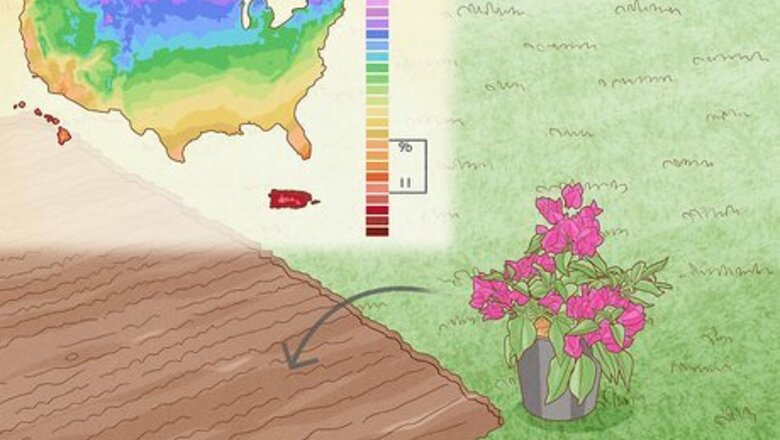
views
- Plant bougainvillea outside in USDA zones 9 through 11. If temperatures dip below freezing where you live, grow it in a pot and move it indoors in winter.
- Grow bougainvillea in a soil and compost mix that doesn’t contain peat moss. Water your bougainvillea when the soil feels dry to the touch.
- Prune bougainvillea vines by cutting off a third of the new growth at the end of summer. Tie the vines to a trellis or fence if you want them to climb up as they grow.
Planting Bougainvillea

Plant bougainvillea outdoors if you’re in zones 9B through 11. Bougainvillea thrives in arid places that are hot and relatively dry. Check a USDA hardiness zone map to find out what growing climate you live in. If you live in zones 9B through 11, bougainvillea will survive outdoors all year long. Bougainvillea do best when night temperatures are warmer than 60 °F (16 °C) but daytime temperatures are cooler than 100 °F (38 °C).

Plant bougainvillea in pots if temperatures dip below freezing. Bougainvilleas will not survive outdoors in cold climates, but they’ll still thrive as a houseplant if you bring them indoors. Keep your bougainvilleas in a pot so you’re able to leave them outside in the summer and bring them indoors for the winter. While you could dig up bougainvilleas from the ground to overwinter them in pots, they have delicate root structures that may not survive the movement. It’s better to plant the bougainvilleas directly in pots so they’re easy to move.

Pick a spot that gets at least 6 hours of sunlight during the day. Bougainvillea needs full sun, or 6 hours of direct light without shade. If you’re planting bougainvillea outdoors, then look for a spot that’s facing south (if you’re in the northern hemisphere) or north (if you’re in the northern hemisphere). If you’re keeping bougainvilleas indoors, place them near a large south-facing (for the northern hemisphere) or north-facing (for the southern hemisphere) window.
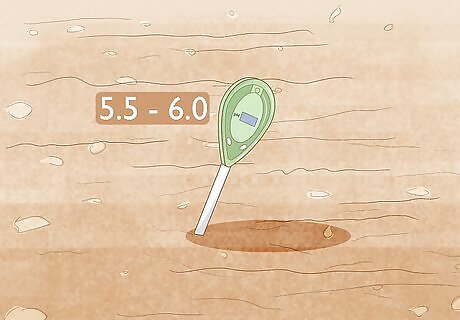
Choose a planting spot with well-drained soil with a pH around 6.0. Bougainvillea grows best in dry conditions, so it doesn't do well when there’s a lot of moisture. Run a soil test using a pH test kit to determine if the planting medium has a slightly acidic pH around 6.0. If you need to, adjust the soil pH before planting your bougainvilleas. To test if your soil is well-draining, dig a hole that’s 12 in (30 cm) wide and 12 in (30 cm) deep. Fill the hole with water and let it drain completely. Then, fill the hole with water again and check the water level change in 1 hour. If the water level dropped by 4 inches (10 cm) or more, the soil is well-draining. If your soil has poor drainage, try mixing in a layer of compost with the topsoil to help it retain less moisture. If you need to raise the soil’s pH, sprinkle lime onto the soil. To lower the pH, spread aluminum sulfate instead. If you’re planting bougainvilleas in containers, stick to a general potting and compost mix. Avoid using mixes that contain any peat moss because they can retain too much water and could cause root rot.
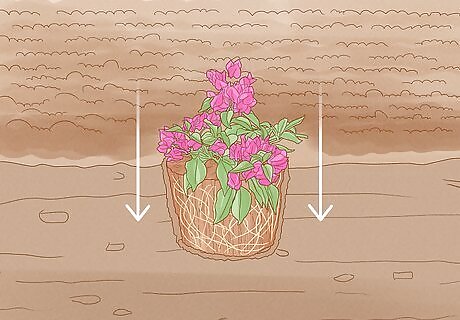
Plant the bougainvillea into the ground or in a pot. If you’re planting directly into the ground, dig a hole as deep as the bougainvillea plant's root ball. If you’re planting in a container, pick a pot with drainage holes that’s just 1–2 inches (2.5–5.1 cm) wider than the bougainvillea’s root ball. Water the bougainvillea lightly and slowly lift it out from the original pot. Without disturbing the roots, set the bougainvillea into the hole or pot. Fill in around the root ball with soil, and lightly pat it down around the base of the plant. In zones 9B through 11, plant bougainvillea any time of the year. If you’re planting bougainvillea in pots, start them in the early spring. If you want the bougainvillea to climb a trellis or wall, be sure to plant it near the structure right away so it can easily grow onto it. Space bougainvilleas about 3–5 feet (0.91–1.52 m) apart if you’re planting multiple in the ground.
Bougainvillea Care, Pest Control, and Propagation
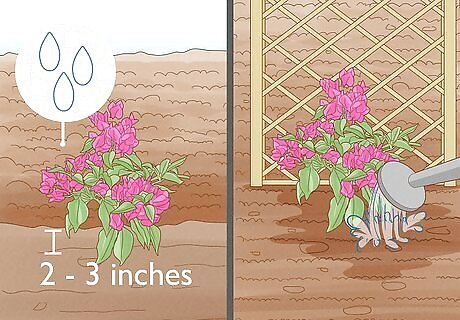
Water bougainvillea when the soil dries out. Bougainvillea plants actually prefer the soil to dry out between waterings since they’re originally from arid climates. Stick a finger into the soil up to your knuckle. If the soil feels dry, then it is time to water. Water the soil until it’s completely saturated or until you see water running out from the drainage holes at the bottom of the container. Typically, you’ll only have to water bougainvillea every few weeks. Avoid overwatering or underwatering your plant because it causes leaves and flowers to drop, or the roots could develop rot.
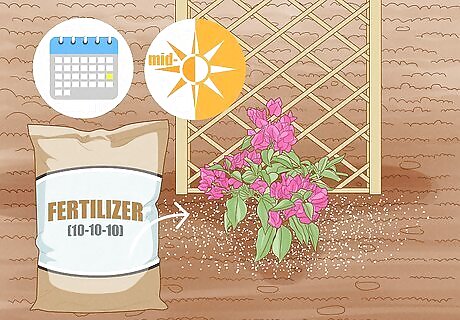
Apply a slow-release 10-10-10 fertilizer once a month through midsummer. Use half the recommended amount of fertilizer on the package so your bougainvilleas don’t grow too much vegetation. Start top-dressing the soil with your fertilizer in the early spring, and immediately water the soil so it soaks in. Apply the fertilizer every month to promote healthy blooms and growth. If you notice your bougainvilleas are looking leggy or not producing as many flowers, cut back on the fertilizer

Prune bougainvillea in the late winter or early spring. After your bougainvillea bloom or right before the growing season, take a pair of pruners and trim off any dead or overcrowded shoots. Trim all the shoots coming off the main stem so only 2 or 3 buds (where leaves or thorns grow from) are left on each of them. Keep trimming away any twiggy or spindly growth until you’ve removed about a third of the total foliage. Wear gardening gloves when pruning bougainvillea because they tend to have thorns or sticky sap that causes skin irritation.

Tie bougainvillea shoots to a fence or trellis to train them to climb. Bougainvillea plants have sprawling vines that can grow on fences, trellises, and walls with a little extra support. If you'd like the plant to grow vertically, tuck the bougainvillea branches through slots in a trellis or fence. Alternatively, tie the shoots to a stake or vertical support using thick twine or fabric strips. As the bougainvillea grows, continue tying more supports along the vine to continue training it in the direction you want. Bougainvillea vines do not have tendrils, so they don’t naturally wrap around or climb surfaces on their own.
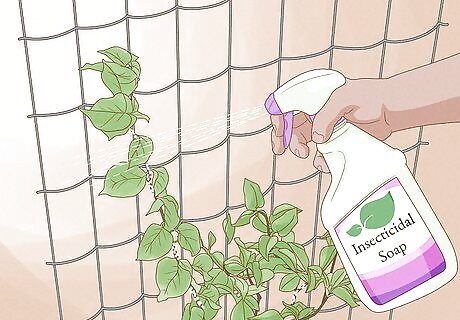
Spray insecticidal soap on your plants if you notice pest damage. While bougainvilleas are usually pretty pest-resistant, they may still attract aphids, mites, or scale insects. If you notice any leaf damage or small insects infesting your bougainvilleas, apply the insecticidal soap directly to the plants to get rid of them. If you notice large circular cutouts from the leaves, you may be dealing with bougainvillea looper caterpillars. Hand-pick any caterpillars you see on your bougainvillea, or apply bacillus thuringiensis pesticides to get rid of them.
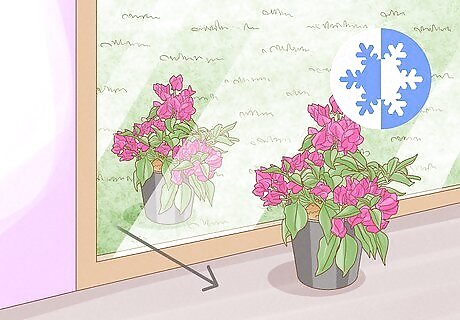
Bring bougainvillea indoors if temperatures drop below freezing. If you live in a hardiness zone that gets below freezing during the winter, take the potted bougainvillea inside for the winter. Keep the plant near a south-facing window (in the northern hemisphere) or a north-facing window (in the southern hemisphere) where it still gets direct sunlight. Keep the temperature above 60 °F (16 °C). It’s normal for bougainvilleas to drop a few leaves and blooms when you move it inside. Just ensure that your plant gets a lot of sunlight and stays warm throughout the day.
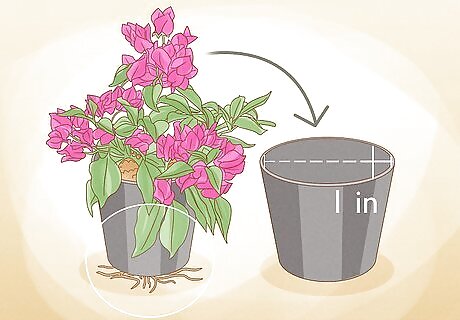
Repot bougainvillea when the roots grow out of the drainage holes. Bougainvilleas don’t mind being a little rootbound in their pot, but roots coming out from the bottom are a sign it’s time to transplant them. Choose a pot about 1 in (2.5 cm) wider than the old one, and ensure it has drainage holes. Water your plant and slowly pull it out from the soil so you don’t disturb the delicate roots. Set the bougainvillea in the new pot and fill in around the roots to finish repotting it.
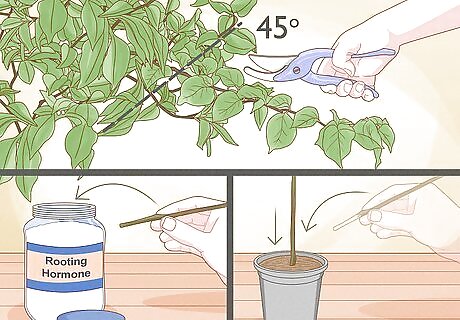
Propagate bougainvillea using cuttings from the current season’s growth. If you want to grow another bougainvillea, look for a fresh shoot that just grew in. Use a pair of pruners to cut off a section that contains 7 nodes, or spots where leaves and thorns grow. Cut the bottom of the stem to a 45-degree angle and dip it rooting hormone before planting it. Water and fertilize the new stem like normal so the new bougainvillea plant establishes.




















Comments
0 comment